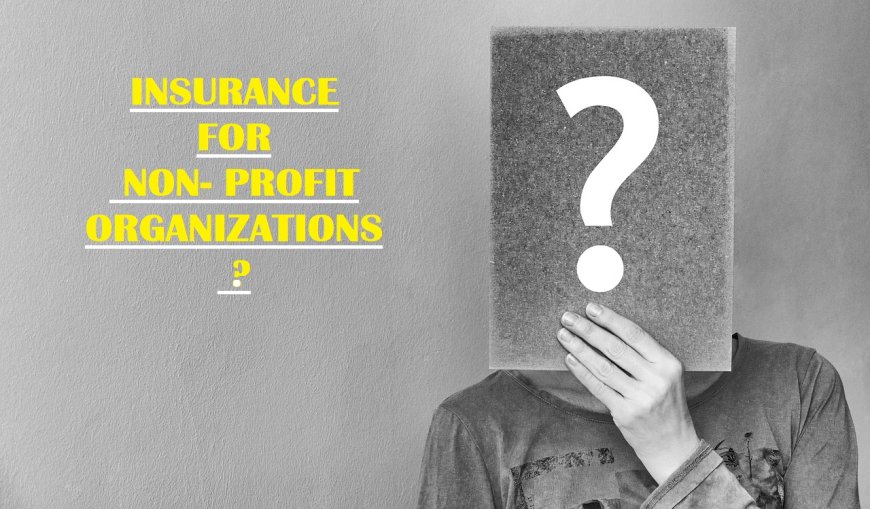Insurance for Non- profit Organizations?
Introduction Non-profit organizations (NPOs) play a vital role in society by addressing various social, environmental,...

Introduction
Non-profit organizations (NPOs) play a vital role in society by addressing various social, environmental, and community needs. These organizations operate with a mission to serve their communities and achieve specific objectives without generating profits for private individuals or shareholders. While their focus is on making a positive impact, non-profits also face risks and uncertainties that can disrupt their operations or cause financial harm. To mitigate these risks, non-profit organizations often turn to insurance solutions designed to protect their assets, people, and mission. In this comprehensive guide, we will delve into the world of insurance for non-profit organizations, exploring the various types of insurance available, the importance of risk management, the process of selecting the right coverage, and tips for cost-effective insurance strategies.
1.1 Definition of Non-profit Organizations
Non-profit organizations (NPOs), also known as non-governmental organizations (NGOs) or charitable organizations, are entities established for purposes other than generating profits for private individuals or shareholders. They exist to fulfill specific missions or objectives, such as addressing social, environmental, educational, or community needs. NPOs can take various forms, including charitable foundations, advocacy groups, religious organizations, educational institutions, and healthcare providers.
1.2 Mission and Operations
The primary focus of non-profit organizations is to make a positive impact on society by advancing their mission. This mission often guides their operations and decision-making. NPOs rely on donations, grants, and other forms of financial support to fund their programs and activities. While they do not distribute profits to shareholders, they aim to allocate resources efficiently to achieve their goals effectively.
2. Risks Faced by Non-profit Organizations
Non-profit organizations are not immune to risks, and their operations can be vulnerable to various threats. It’s important for NPOs to identify, assess, and manage these risks effectively to protect their assets and maintain their ability to fulfill their missions.
2.1 Financial Risks
Financial risks are a significant concern for non-profit organizations. These risks may include:
- Fluctuations in Donations: NPOs often rely on donations, which can be unpredictable and subject to economic conditions.
- Investment Risks: Non-profit organizations may invest their assets to generate income.
- Budgetary Constraints: NPOs typically operate on limited budgets. Unexpected expenses or revenue shortfalls can strain their finances.
2.2 Liability Risks
Liability risks involve potential legal claims and disputes. Non-profit organizations may face liability risks in several areas:
- Personal Injury Claims: Accidents or injuries on the organization’s premises or during events can lead to liability claims.
- Employment-related Claims: Disputes with employees or volunteers, such as discrimination or wrongful termination claims.
- Board of Directors Liability: Board members can be held personally liable for decisions made on behalf of the organization.
- Third-party Liability: Non-profits can be sued by individuals or other organizations for various reasons, such as negligence or defamation.
3. The Role of Insurance in Non-profit Organizations
3.1 What is Non-profit Insurance?
Non-profit insurance, also known as non-profit organization insurance or NPO insurance, refers to a range of insurance products designed specifically to address the unique risks faced by non-profit organizations. These insurance policies are tailored to the needs of NPOs and can provide financial protection in the event of unexpected events or liabilities.
3.2 Benefits of Non-profit Insurance
Non-profit insurance offers several key benefits to organizations:
- Financial Protection: Insurance policies provide financial support to cover losses or liabilities, reducing the financial burden on the organization.
- Risk Mitigation: Insurance helps NPOs manage risks effectively, allowing them to focus on their mission without constantly worrying about potential threats.
4. Types of Insurance for Non-profit Organizations
Non-profit organizations can choose from a variety of insurance policies to address their specific risks. The type and extent of coverage needed depend on the nature of the organization’s activities, size, and potential exposures. Below are some of the common types of insurance for non-profit organizations:
4.1 General Liability Insurance
General liability insurance, also known as commercial general liability (CGL) insurance, provides coverage for bodily injury, property damage, and personal injury claims that may arise during the course of the organization’s operations. It can protect the organization from legal expenses and settlement costs associated with such claims.
4.2 Directors and Officers (D&O) Insurance
Directors and Officers insurance (D&O) is crucial for non-profit organizations because it protects board members, officers, and executives from personal liability in the event of alleged wrongful acts or mismanagement. D&O insurance helps attract qualified individuals to serve on the board and provides financial protection for those who do.
4.3 Property Insurance
Property insurance covers physical assets owned by the non-profit organization, such as buildings, equipment, and office contents, against risks like fire, theft, vandalism, and natural disasters. This coverage ensures that the organization can repair or replace damaged property without bearing the full financial burden.
4.4 Workers’ Compensation Insurance
Workers’ compensation insurance is essential for non-profit organizations with employees or volunteers. It provides coverage for medical expenses and lost wages for employees who suffer work-related injuries or illnesses. Compliance with workers’ compensation laws is often a legal requirement.
5. Risk Management for Non-profit Organizations
Effective risk management is essential for non-profit organizations to identify, assess, and mitigate potential risks.Here are key steps in risk management for NPOs:
5.1 Identifying Risks
The first step in risk management is to identify all potential risks that the organization may face. This includes financial, liability, operational, and reputational risks. To identify risks, organizations can conduct risk assessments, review historical incidents, and seek input from staff, board members, and stakeholders.
5.2 Risk Assessment and Prioritization
Once risks are identified, organizations should assess and prioritize them based on factors such as the likelihood of occurrence and the potential impact. High-priority risks should be addressed first to ensure that resources are allocated effectively.
Conclusion
Non-profit organizations play a crucial role in addressing social, environmental, and community needs. To fulfill their missions effectively, NPOs must navigate various risks and uncertainties. Insurance for non-profit organizations is a vital tool for managing these risks, protecting assets, and ensuring the continuity of their valuable work.
Thank You





